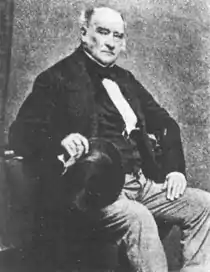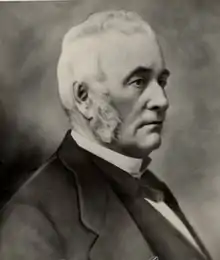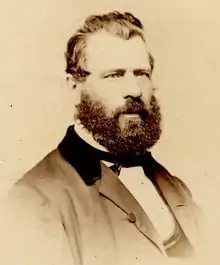| Defunct pre-Confederation electoral district | |
|---|---|
| Legislature | Legislative Assembly of the Province of Canada |
| District created | 1841 |
| District abolished | 1867 |
| First contested | 1841 |
| Last contested | 1865 |
Three Rivers (French name: Trois-Rivières) was an electoral district of the Legislative Assembly of the Parliament of the Province of Canada, in Canada East. It was centered on the town of Trois-Rivières (known at that time as "Three Rivers" in English). The district was created in 1841, based in part on the previous electoral district of the same name in the Parliament of Lower Canada.
Three Rivers electoral district was represented by one member in the Legislative Assembly. The district was abolished in 1867, upon the creation of Canada and the province of Quebec.
Boundaries
Three Rivers electoral district was located on the north shore of the Saint Lawrence River, midway between Quebec City and Montreal. It was created in 1841, upon the establishment of the new Province of Canada. Although it was centered on the town of Trois-Rivières, in the same way as the predecessor electoral district of the same name for Lower Canada, its boundaries had been significantly altered by the Governor General, Lord Sydenham, to favour voters of British background over the francophone Canadiens. Sydenham wanted to ensure members were elected who would support the new union and his government and drew the boundaries with this goal. It was an example of a linguistic and ethnic gerrymander.[1][2]
The Union Act, 1840 merged the two provinces of Upper Canada and Lower Canada into the Province of Canada, with a single Parliament. The separate parliaments of Lower Canada and Upper Canada were abolished.[3] The Union Act provided that the pre-existing electoral boundaries of Lower Canada and Upper Canada would continue to be used in the new Parliament, unless altered by the Union Act itself.[4]
Three Rivers was one of the electoral districts specifically defined in the Union Act. The Act provided that the town would continue as a separate electoral district, electing one member to the Legislative Assembly.[5] However, instead of continuing the district under the previous boundaries, the Act gave the Governor General the power to draw new boundaries for the district.[6] The Governor General exercised this power by a proclamation on March 4, 1841, only four days before the elections were to begin on March 8.[7][8]
The boundaries set by the Proclamation were as follows:
The effect of these boundaries was to contract the electoral district, excluding the outlying areas of the town, which had a largely French-speaking population, thus diluting the voting strength of the francophone voters.[1]
Members of the Legislative Assembly (1841–1867)
Three Rivers was a single-member constituency.[4]
The following were the members of the Legislative Assembly for Three Rivers. The party affiliations are based on the biographies of individual members given by the National Assembly of Quebec, as well as votes in the Legislative Assembly. "Party" was a fluid concept, especially during the early years of the Province of Canada.[9][10][11]
| Parliament | Members | Years in Office | Party | |||
|---|---|---|---|---|---|---|
| 1st Parliament 1841–1844 |
Charles Richard Ogden |  |
1841–1844 | Unionist; "British" Tory | ||
| 2nd Parliament 1844–1847 |
Edward Greive[lower-alpha 1] | 1844–1845 | Tory | |||
| Denis-Benjamin Viger[lower-alpha 2] | .jpg.webp) |
1845–1847 (by-election) |
"British" Tory | |||
| 3rd Parliament 1848–1851[lower-alpha 3] |
Antoine Polette |  |
1848–1857 | French-Canadian Group | ||
| 4th Parliament 1851–1854 |
Ministerialist, then temporary opposition moderate | |||||
| 5th Parliament 1854–1857 |
Moderate, then Bleu | |||||
| 6th Parliament 1858–1861 |
William McDonell Dawson | 1858–1861 | Conservative | |||
| 7th Parliament 1861–1863 |
Joseph-Édouard Turcotte |  |
1861–1864 | Bleu | ||
| 8th Parliament 1863–1867 |
Joseph-Édouard Turcotte[lower-alpha 4] |  |
||||
| Louis-Charles Boucher de Niverville[lower-alpha 5] | 1865–1867 (by-election) |
Bleu | ||||
Notes
- ↑ Died in office, June 1845: Côté, Political Appointments and Elections, pp. 47, 60, note (83).
- ↑ Elected in by-election, July 14, 1845: Côté, Political Appointments and Elections, pp. 47, 60, note (84).
- ↑ No member was returned in the general election; Antoine Polette was elected in a by-election, April 26, 1848: Côté, Political Appointments and Elections, pp. 51, 61, note (122).
- ↑ Died in office, December 20, 1864: "Biography of Joseph-Édouard-Turcotte". Dictionnaire des parlementaires du Québec de 1792 à nos jours (in French). National Assembly of Quebec.
- ↑ Elected in by-election, January 16, 1865: J.O. Côté, Political Appointments and Elections in the Province of Canada from 1841 to 1865, 2nd ed. (Ottawa: G.E. Desbarats, 1865), p. 117.
Abolition
The district was abolished on July 1, 1867, when the British North America Act, 1867 came into force, creating Canada and splitting the Province of Canada into Quebec and Ontario.[12] It was succeeded by electoral districts of the same name in the House of Commons of Canada[13] and the Legislative Assembly of Quebec.[14]
See also
References
- 1 2 Irving Martin Abella, "The 'Sydenham Election' of 1841" (1966), 47 Canadian Historical Review 326, p. 334 [subscription needed].
- ↑ Paul G. Cornell, Alignment of Political Groups in Canada 1841-1867 (Toronto: University of Toronto Press, 1962), p. 4.
- ↑ Union Act, 1840, 3 & 4 Vict., c. 35, s. 2.
- 1 2 Union Act, 1840, s. 18.
- ↑ Union Act, 1840, s. 20.
- ↑ Union Act, 1840, s. 21.
- 1 2 "Proclamation, March 4, 1841", Journals of the Legislative Council of the Province of Canada, 1st Parliament, 1st Session, 1841, p. xiv.
- ↑ Abella, "The 'Sydenham Election' of 1841", p. 337.
- ↑ J.O. Côté, Political Appointments and Elections in the Province of Canada, 1841 to 1860 (Quebec: St. Michel and Darveau, 1860), pp. 43–58.
- ↑ Québec Dictionary of Parliamentary Biography, from 1764 to the present.
- ↑ Paul G. Cornell, Alignment of Political Groups in Canada, 1841–67 (Toronto: University of Toronto Press, 1962; reprinted in paperback 2015), pp. 93–111.
- ↑ British North America Act, 1867 (now the Constitution Act, 1867), s. 6.
- ↑ Constitution Act, 1867, s. 40, para. 2
- ↑ Constitution Act, 1867, s. 80.
![]() This article incorporates text from this source, which is in the public domain: "Proclamation, March 4, 1841", Journals of the Legislative Council of the Province of Canada, 1st Parliament, 1st Session, 1841, p. xiv.
This article incorporates text from this source, which is in the public domain: "Proclamation, March 4, 1841", Journals of the Legislative Council of the Province of Canada, 1st Parliament, 1st Session, 1841, p. xiv.